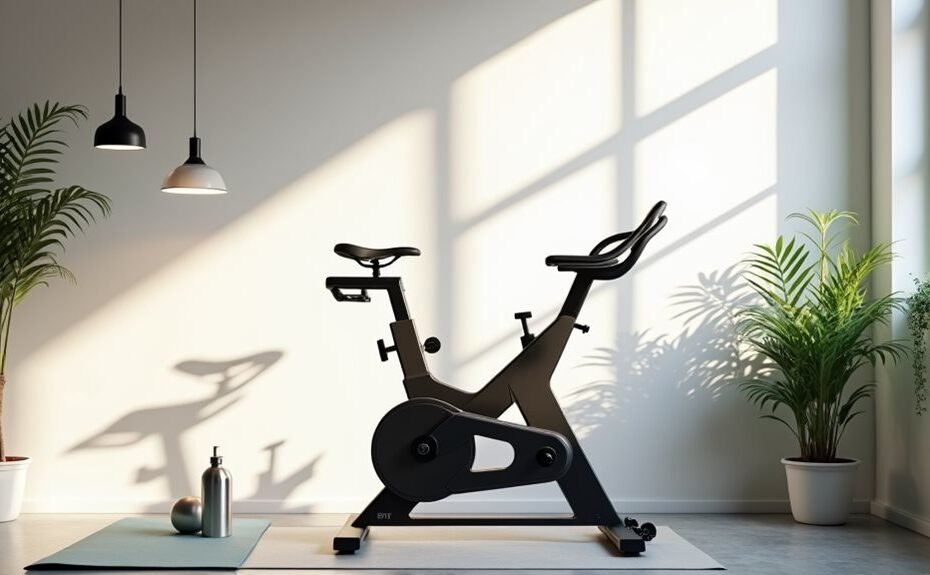I've transformed countless riders from hesitant beginners to confident athletes through customized static bike training, and I'm confident I can help you do the same. Whether you're recovering from an injury, seeking a low-impact workout, or dreaming of conquering virtual mountains, your journey starts with understanding how to tailor your indoor cycling experience. There's more to static bike success than simply pedaling – it's about creating the perfect blend of equipment, technique, and progressive challenges that align with your unique goals. Let me show you how to reveal your full potential.
Key Takeaways
- Start with 20-minute sessions three times weekly, gradually increasing duration and intensity as fitness improves.
- Monitor heart rate around 150 bpm during workouts while maintaining proper form for optimal cardiovascular benefits.
- Combine endurance rides with HIIT intervals to build strength and improve overall stamina.
- Track progress using heart rate monitors and apps, setting measurable goals for continuous improvement.
- Adjust bike settings regularly, including saddle height and handlebar position, to maintain comfort during longer sessions.
Choosing Your Perfect Indoor Bike
Three main types of indoor bikes dominate today's market: smart bikes, spin bikes, and budget-friendly options. I'll help you cut through the noise and pick the right one for your goals and wallet.
Smart bikes are your high-end powerhouses. If you're serious about training and have £1,899-£4,000 to spend, these babies offer everything: realistic ride feel, power measurement, and compatibility with apps like Zwift. You'll get virtual shifting and simulated terrain – it's practically outdoor cycling indoors. The NordicTrack S22i stands out with its incline and decline features for an authentic riding experience. Most modern smart bikes offer WiFi connectivity for dropout-free training sessions.
Spin bikes hit the sweet spot for HIIT enthusiasts. Starting around $500, you'll get magnetic resistance for quiet operation and enough features to crush those high-intensity workouts. The Schwinn IC4 and Echelon Smart Connect EX3 are solid picks here.
On a tight budget? Don't sweat it. Basic exercise bikes under $200 still deliver what you need for moderate workouts. Sure, you won't get fancy apps or magnetic resistance, but you'll still burn calories and build fitness. The Domyos Basic Exercise Bike 100 proves you don't need to break the bank to break a sweat.
Setting Up For Success
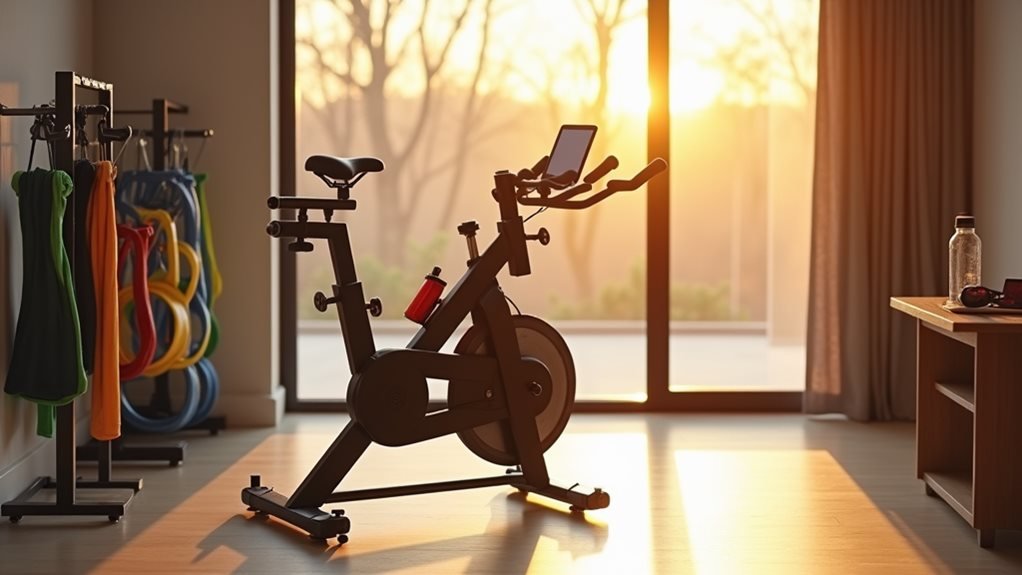
Proper setup is the cornerstone of a safe and effective indoor cycling experience. Let's get you positioned perfectly, because I won't let you waste a single pedal stroke on poor form.
Start with your saddle height – it should hit right at your hip bone when you're standing next to the bike. Trust me, your knees will thank you later. Taking time for a proper bike fit will enhance your workout effectiveness and prevent potential injuries. When seated, aim for a slight knee bend at the lowest pedal position.
Now, let's nail that fore and aft position. Your knee should align perfectly with the pedal at the bottom of your stroke, and you'll know you've got it right when your toes briefly disappear on the upstroke. I'm not kidding – this detail matters.
For the handlebars, we're keeping it simple: match them to your saddle height or slightly higher. I see too many beginners trying to mimic Tour de France positions – that's not what we're doing here. Keep those elbows slightly bent and your spine neutral.
Here's your posture checklist: chest up, shoulders relaxed, back flat. And please, stop death-gripping those handlebars – they're not going anywhere. Remember: circular pedal strokes, not stomping motions. It's like dancing with your bike, just less awkward.
Building Your Fitness Foundation
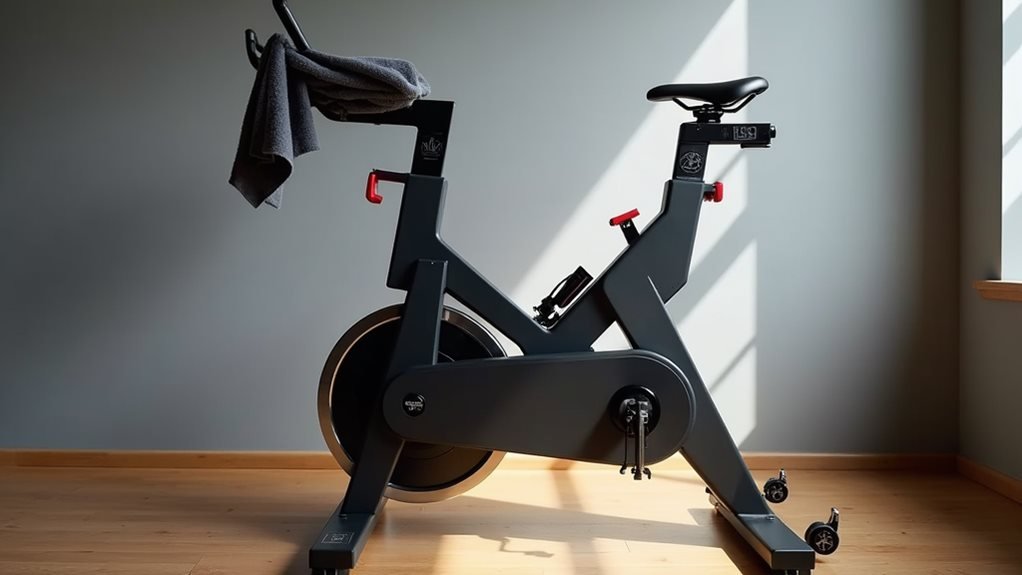
Now that you're set up correctly, let's build your strength and stamina. I'll guide you through a proven approach that targets your entire body while protecting your joints. Trust me – your legs, core, and cardiovascular system are about to get the workout they've been craving.
Start with 20-minute sessions, three times a week. I know you want to go harder, but restraint now means success later. Keep your resistance low initially – you're building habits, not breaking records. Your recumbent bike option might be best if you have balance concerns.
Watch your heart rate hover around 150 bpm; that's your sweet spot for cardiovascular gains without overexertion. For accuracy in tracking your progress, use a heart rate monitor during your workout sessions.
Here's what's happening while you pedal: Your joints are getting bathed in synovial fluid (nature's lubricant), your muscles are strengthening to support your frame, and your heart's getting more efficient with every revolution.
If you're dealing with arthritis or joint issues, you're in luck – static bikes are practically designed for you. The low-impact nature means you're building strength without the wear and tear of high-impact exercises.
Remember: consistency trumps intensity. Stick to the plan, and you'll be amazed at your progress.
Maximizing Workout Performance
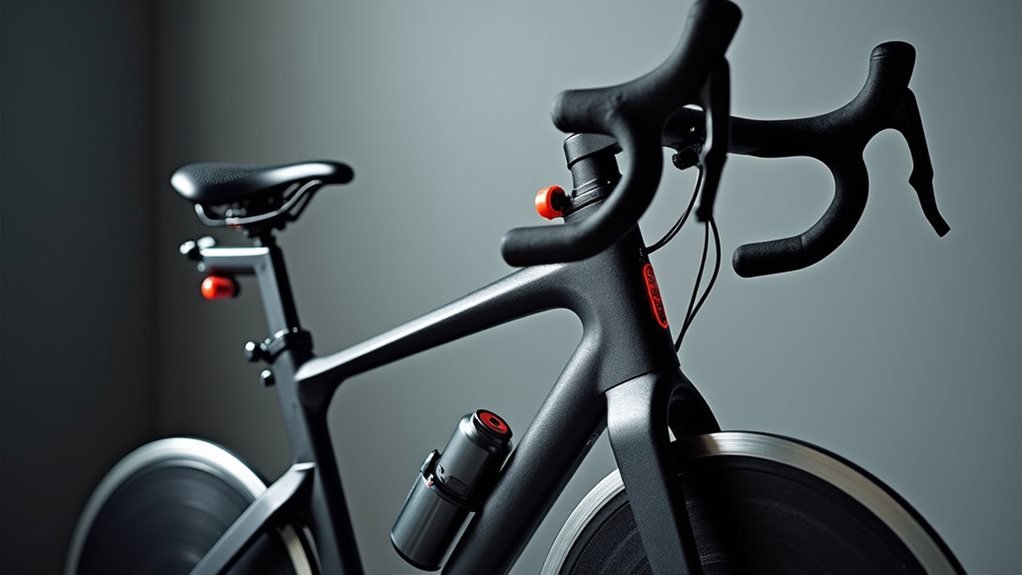
Mix things up to stay sharp. One day, tackle endurance rides; the next, challenge yourself with HIIT sessions. Use ERG mode if you've got it – it's like having a drill sergeant controlling your resistance. And don't forget to track your progress. Nothing beats the satisfaction of watching those numbers climb. Stationary bike training can provide low-impact, high-intensity workouts that effectively improve cardiovascular fitness. Incorporating these varied workouts will help strengthen your heart and improve overall fitness. A well-structured interval training routine can boost calorie burn even after your workout ends.
Tracking Progress Like A Pro
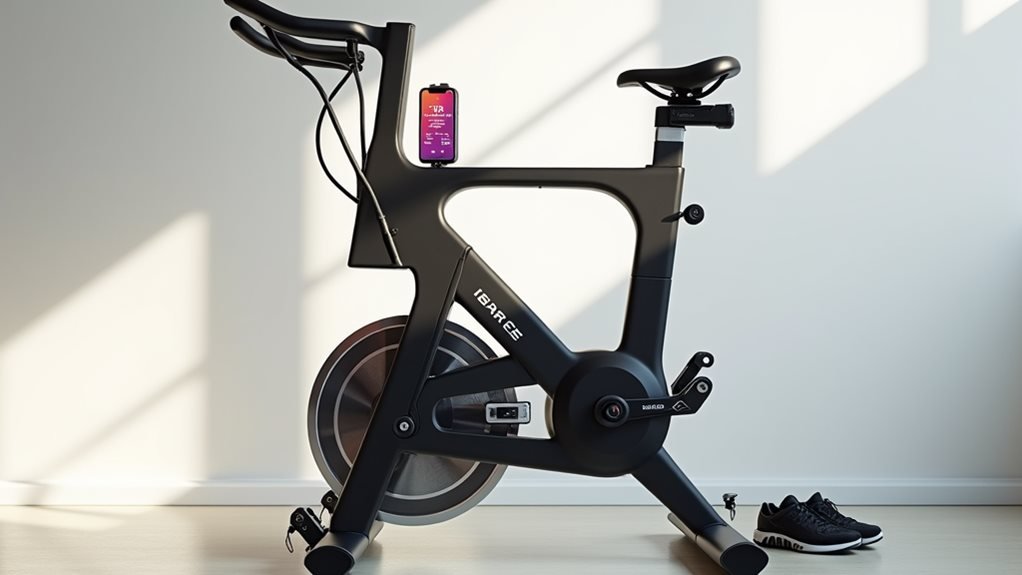
On your journey to cycling success, tracking progress is the key to staying motivated and reaching your goals. I'll show you how to monitor your performance like a seasoned pro, using both high-tech tools and old-school methods.
Let's start with your heart – it's your built-in performance meter. Strap on a heart rate monitor and watch those zones. Trust me, a dropping resting heart rate means you're getting fitter. Connect your monitor to apps like Polar or Strava, and you've got instant data tracking. Consider using TrainingPeaks for detailed analysis of your heart rate data. For users with a Fitbit Flex 2, you'll need to manually log activities on your stationary bike sessions. Indoor cycling benefits extend beyond just tracking metrics, including improved heart health and calorie burning.
Don't have fancy gear? No problem. Grab a notebook and start logging. Record everything: duration, intensity, how you felt. It's not glamorous, but it works.
For the tech-savvy cyclists, I recommend adding a Wahoo RPM sensor for cadence tracking and a speed sensor for distance metrics.
Here's the deal: focus on what matters. Track your cadence – it's your cycling efficiency score. Monitor how long you can maintain recommended RPMs. Watch your power output climb. And don't forget the ultimate metric: how easily you bound up those stairs after weeks of training. That's real progress, measured in real life.
Long-Term Equipment Care
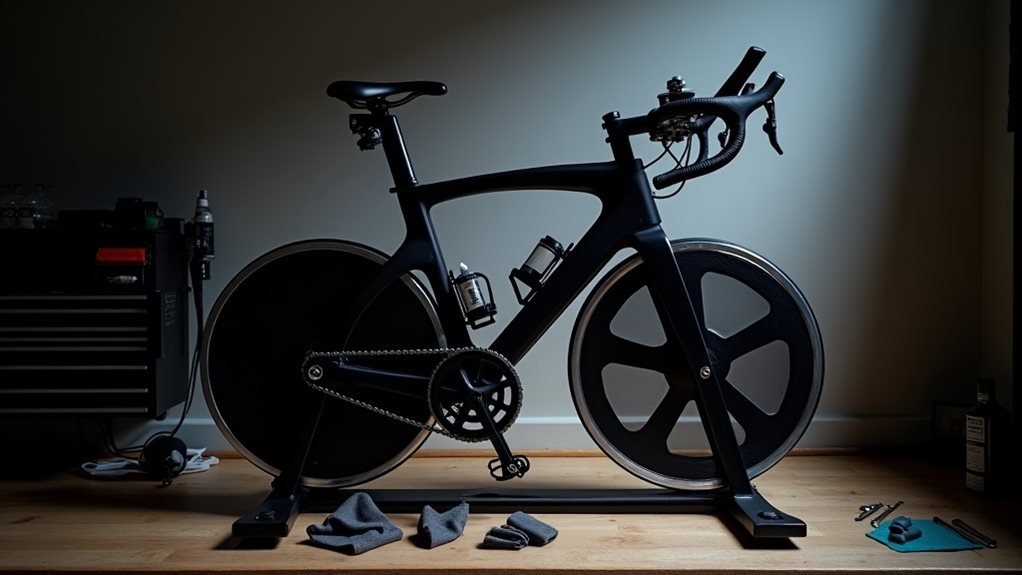
Every static bike requires consistent attention to maintain peak performance and longevity. I'll tell you exactly how to keep your investment running smoothly, and trust me, you'll thank me later.
Daily maintenance isn't optional – it's your bike's lifeline. After each sweaty session, wipe down those high-touch areas. I'm talking handlebars, saddle, and pedals. Don't let that corrosive sweat wreak havoc on your equipment. Before you ride, check for any suspicious vibrations and make sure everything's locked tight.
Weekly, you'll need to get more intimate with your bike. Clean that flywheel thoroughly, and don't forget to remove and clean the saddle and handlebar posts. A little silicone oil on those adjustment knobs works wonders.
Monthly, focus on the moving parts. Whether you've got a chain or belt drive, proper lubrication is essential. And don't skip those annual check-ups – they're like your bike's physical exam. Replace worn parts like brake pads and pedals when needed. Remember, a well-maintained bike isn't just about performance – it's about safety and longevity. Resistance mechanism maintenance is crucial for ensuring smooth operation and preventing unexpected wear and tear.
Frequently Asked Questions
Can Indoor Cycling Affect Knee Health Over Time?
I'll tell you that indoor cycling can strengthen your knees when done properly, but poor form and incorrect bike setup may cause joint problems. That's why I recommend proper adjustments.
How Much Clearance Space Is Needed Around a Stationary Bike?
Like creating a safety bubble around your workout sanctuary, I recommend maintaining at least 1-2 feet of clearance on all sides, with extra space (2-3 feet) behind for dismounting.
Should I Wear Cycling Shoes or Regular Sneakers?
I'd strongly recommend cycling shoes over sneakers. They'll improve your power transfer, prevent foot slips, reduce injury risk, and enhance overall pedaling efficiency during your indoor cycling workouts.
How Often Should I Take Rest Days Between Cycling Workouts?
Listen up: slow and steady wins the race. I'd recommend taking at least one complete rest day weekly, plus extra recovery days after intense workouts. Pay attention to fatigue signals your body's giving you.
Does Room Temperature Impact the Bike's Electronic Components?
I recommend keeping your bike in a room between 41°F-77°F (5°C-25°C). Extreme temperatures can damage displays, affect battery performance, and cause issues with electronic components and motor efficiency.
